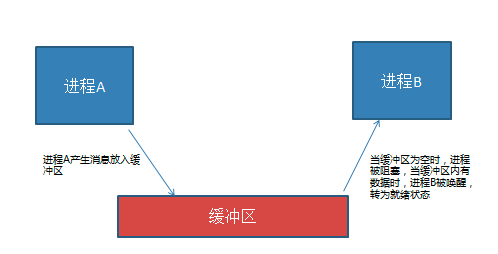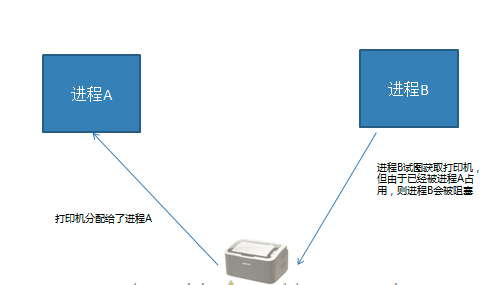线程
线程是一种多任务编程的方式,可以使用计算机多核资源。线程又被称为轻量级的进程
线程特征
* 线程是计算机核心分配的最小单位
* 一个进程可以包含多个线程
* 线程也是一个运行过程,也要消耗计算机资源。多个线程共享其进程的资源和空间
* 线程也拥有自己特有的资源属性,比如指令集,TID等
* 线程无论创建还是删除还是运行资源消耗都小于进程
* 多个线程之间并行执行,互不干扰
threading线程模块
from threading import Thread
t = Thread(target, [, args], [kwargs])
创建线程对象
- target 绑定线程函数
- args 元组 给线程函数位置传参
- kwargs 字典 给线程函数键值传参
t.start() 启动线程
t.join([timeout]) 回收线程
import threading import os a = 1 # 线程函数 def music(): print("进程pid号", os.getpid()) global a print("a = ",a) a = 10000 t = threading.Thread(target=music) # 创建线程对象 t.start() # 启动线程 print("进程pid号", os.getpid()) t.join() # 回收线程 print("Main a:",a) # 进程pid号 12549 # 进程pid号 12549 # a = 1 # Main a: 10000
os.getpid获取的是进程的pid号,线程是进程中的一个成员.
线程中改的变量,是进程中的变量.并没有新开辟一个空间.
线程属性
t.is_alive() 查看线程状态
t.name 线程名称 默认Thread-1
t.setName() 设置线程名称
threading.currentThread() 获取当前线程对象

1 from threading import Thread,currentThread 2 from time import sleep 3 4 #线程函数 5 def fun(sec): 6 print("线程属性测试") 7 sleep(sec) 8 #获取线程对象 getName()获取名字 9 print("%s 线程结束"%currentThread().getName()) 10 11 thread = [] 12 13 for i in range(3): 14 t = Thread(target = fun,name = "tedu%d"%i, 15 args = (3,)) 16 thread.append(t) 17 t.start() 18 print(t.is_alive()) #查看进程状态 19 20 thread[1].setName('Tarena') #设置线程名称 21 print(thread[2].name) #获取线程名称 22 23 #回收线程 24 for i in thread: 25 i.join() 26 27 # 线程属性测试 28 # True 29 # 线程属性测试 30 # True 31 # 线程属性测试 32 # True 33 # tedu2 34 # Tarena 线程结束 35 # tedu0 线程结束 36 # tedu2 线程结束
t.daemon
默认情况下,主线程的结束不会影响分支线程,如果设置为True则主线程退出分支线程也会退出
设置方法:
t.daemon = True
t.setDaemon()
线程daemon属性的设置在start前;一般设置daemon后不会使用join
from threading import Thread from time import sleep def fun(): sleep(3) print("线程属性测试") t = Thread(target=fun, name = "Tarena") # 主线程退出分支线程也退出 t.setDaemon(True) t.start() t.setName("Tedu") print("Name:",t.getName()) # 线程名称 print("Alive:",t.is_alive()) # 线程生命周期 print("is Daemon",t.isDaemon()) # 主进程随着分支进程退出
自定义线程类
- 继承Thread类
- 运行Thread类中的__init__方法以获取父类属性
- 重写run方法
使用方法
- 实例化对象
- 调用start自动化执行run方法
- 调用join回收线程
from threading import Thread class ThreadClass(Thread): # 重写父类init def __init__(self, *args, **kwargs): self.attr = args[0] super().__init__() # 加载父类init def fun1(self): print("函数1") def fun2(self): print("函数2") # 重写run,逻辑调用 def run(self): self.fun1() self.fun2() t = ThreadClass("abc") t.start() t.join() # 函数1 # 函数2
同步互斥
线程间通信方法
1.通信方法:线程间使用全局变量进行通信
2. 共享资源争夺
- 共享资源:多个进程或者线程都可以操作的资源称为共享资源。对共享资源的操作代码段称为临界区。
- 影响 :对共享资源的无序操作可能会带来数据的混乱,或者操作错误。此时往往需要同步互斥机制协调操作顺序。
3. 同步互斥机制
同步 : 同步是一种协作关系,为完成操作,多进程或者线程间形成一种协调,按照必要的步骤有序执行操作。

互斥 : 互斥是一种制约关系,当一个进程或者线程占有资源时会进行加锁处理,此时其他进程线程就无法操作该资源,直到解锁后才能操作。

线程同步互斥方法
线程Event
from threading import Event
e = Event() 创建线程event对象
e.wait([timeout]) 阻塞等待e被set
e.set() 设置e,使wait结束阻塞
e.clear() 使e回到未被设置状态
e.is_set() 查看当前e是否被设置
from threading import Thread,Event s = None # 用于通信 e = Event() # 创建event对象 def 杨子荣(): print("杨子荣前来拜山头") global s s = "天王盖地虎" e.set() # 对e设置 t = Thread(target=杨子荣) t.start() print("说对口令就是自己人") e.wait() # 阻塞等待口令说出 if s == '天王盖地虎': print("宝塔镇河妖") print("确认过眼神,你是对的人") else: print("打死他...") t.join()
线程锁 Lock
from threading import Lock
lock = Lock() 创建锁对象
lock.acquire() 上锁 如果lock已经上锁再调用会阻塞
lock.release() 解锁
with lock: # 上锁
...
...
with代码块结束自动解锁
from threading import Thread,Lock a = b = 0 lock = Lock() # 定义锁 def value(): while True: lock.acquire() # 上锁 if a != b: print("a = %d,b = %d"%(a,b)) lock.release() # 解锁 t = Thread(target = value) t.start() while True: # 上锁 with lock: a += 1 b += 1 # 自动解锁 t.join()
python线程的GIL问题
GIL (全局解释器锁)
python ---》 支持线程操作 ---》IO的同步和互斥 --》 加锁 ----》 超级锁,给解释器加锁
后果:一个解释器,同一时刻只解释一个线程,此时其他线程需要等待。大大降低了python线程的执行效率
python GIL问题解决方案
* 修改c解释器
* 尽量使用多进程进行并行操作
* python线程可以用在高延迟多阻塞的IO情形
* 不使用cpython c# java做解释器
效率测试
分别测试 多进程 多线程 单进程执行相同的IO操作和CPU

#计算密集 def count(x,y): c = 0 while c < 7000000: x += 1 y += 1 c += 1 #io密集 def write(): f = open("test.txt",'w') for x in range(2000000): f.write("hello world ") f.close() def read(): f = open("test.txt") lines = f.readlines() f.close()
操作的时间

#单进程程序 from test import * import time # t = time.time() # for i in range(10): # count(1,1) # print("Line cpu:",time.time() - t) t = time.time() for i in range(10): write() read() print("Line IO:",time.time() - t)
Line cpu: 8.15166711807251
Line IO: 6.841825246810913

from test import * import threading import time counts = [] t = time.time() for x in range(10): th = threading.Thread(target = count,args = (1,1)) th.start() counts.append(th) for i in counts: i.join() print("Thread cpu",time.time() - t)

from test import * import threading import time counts = [] def io(): write() read() t = time.time() for x in range(10): th = threading.Thread(target = io) th.start() counts.append(th) for i in counts: i.join() print("Thread IO",time.time() - t)
Thread cpu 8.414522647857666
Thread IO 6.023292541503906

from test import * import multiprocessing import time counts = [] t = time.time() for x in range(10): th = multiprocessing.Process (target = count,args = (1,1)) th.start() counts.append(th) for i in counts: i.join() print("Process cpu",time.time() - t)

from test import * import multiprocessing import time counts = [] def io(): write() read() t = time.time() for x in range(10): th = multiprocessing.Process(target = io) th.start() counts.append(th) for i in counts: i.join() print("Process IO",time.time() - t)
Process cpu 4.079084157943726
Process IO 3.2132551670074463
进程和线程的区别和联系
- 两者都是多任务编程的方式,都能够使用计算机的多核
- 进程的创建删除要比线程消耗更多的计算机资源
- 进程空间独立,数据安全性好,有专门的进程间通信方法
- 线程使用全局变量通信,更加简单,但是需要同步互斥操 作
- 一个进程可以包含多个线程,线程共享进程的空间资源
- 进程线程都独立执行,有自己的特有资源如属性,id, 命令集等
使用情况:
- 一个进程中并发任务比较多,比较简单,适合使用多线程
- 如果数据程序比较复杂,特别是可能多个任务通信比较多 的时候,要考虑到使用线程同步互斥的复杂性
- 多个任务存在明显差异,和功能分离的时候没有必要一定 写入到一个进程中
- 使用python考虑线程GIL问题
